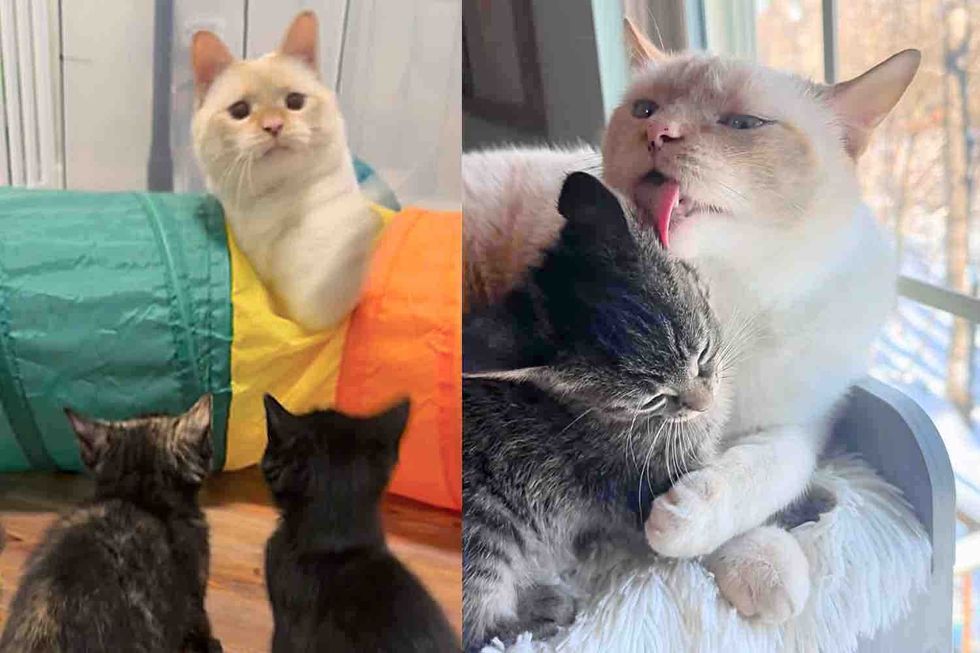
www.lovemeow.com
Kittens Arrive at a Foster Home and Meet Residents Who are Ready to Show Them 'How to Cat'
Three kittens arrived at their foster home and met feline residents who were ready to show them "how to cat." Jennifer @newkittensontheblockThree kittens, Cricket, Firefly, and Beetle, came to the Humane Society for Hamilton County in search of a fresh start.With round-the-clock care from a dedicated bottle feeder, they grew bigger and stronger each day. Once fully weaned, the kittens were transferred to Jennifer's home, where her resident cats eagerly awaited their arrival."They are super sweet and playful and want lots of attention," Jennifer shared. "They purred when I talked to them while they were still in their carrier." Jennifer @newkittensontheblockThe trio quickly settled into their new space, but their hearts were set on one thing: their foster mom's undivided attention. The moment Jennifer entered the room, all three erupted into a chorus of meows, standing on their hind legs and begging for affection."They were not pleased when I told them I had to go to bed." Jennifer @newkittensontheblockTheir squeaky meows and nonstop pitter-patter soon caught the attention of the feline residents, Bear and Bodie. The two lingered by the door, ready to invite themselves in to meet the newcomers.Bear and Bodie are used to having foster kittens around. They have helped countless little ones, showing them how to play and teaching them proper feline etiquette. Beetle, Firefly, and CricketJennifer @newkittensontheblockBodie soon made his grand entrance, strutting in with his bushy tail held high. The kittens, who had never encountered a cat his size, were stunned and puffed themselves up in an attempt to look bigger.Firefly, the tortie, and Beetle, the little house panther, "greeted" him with hisses. Bodie, completely unfazed, strolled past them toward the food bowl, as if he knew it was all bark and no bite. Bodie met the foster kittensJennifer @newkittensontheblock"The little love bugs were skeptical when they met Bodie for the first time. They were curious and followed him around while being puffed in the process. Beetle was the most hissy, but she also sometimes hisses at toys while she's playing."Once Bodie settled onto a cat tree, the kittens became mesmerized by his fluffy tail, which swayed back and forth like a glorious duster. Jennifer @newkittensontheblockThey sat shoulder to shoulder, watching intently, until Beetle gathered the courage to make the first move, stretching up on her tiptoes to bat at his tail. "In the end, they discovered that Bodie's tail is not so scary."After a few days, Bear joined in, showing the kittens how to play with toys. The trio followed in his paw steps, imitating him as their confidence grew. Bear and BeetleJennifer @newkittensontheblockFirefly was drawn to the resident cats and curled up beside them for cuddles or grooming sessions."What she loves most of all is love, especially, human affection," Jennifer said. "I could be holding her right up against me, giving her all the snuggles, and she'd still meow at me because she wasn't close enough. All you have to do is look at her to get her purr motor going." Firefly adored Bear and BodieJennifer @newkittensontheblockThe kittens followed the resident cats everywhere, eager for their next adventure. With toys strewn across the room, Bear enjoyed the fun just as much as his little proteges, who watched in awe as he expertly swatted at the feather wand."Bear is really just a giant kitten." Bear is a kitten at heartJennifer @newkittensontheblockWith the guidance of the feline mentors, the kittens blossomed into confident, playful young cats with vibrant personalities. When they were ready for adoption, it didn't take long for all three to find their forever homes in time for Christmas.Bear and Bodie, proud of the role they played, are ready to welcome the next group of foster kittens and teach them "how to cat." Jennifer @newkittensontheblockShare this story with your friends. More on Jennifer's fosters on Instagram @newkittensontheblock and Humane Society for Hamilton County @hamiltonhumane.Related story: Shy Cats Depend on Each Other Their Whole Lives Meet Person Who Comes Back to Shelter Just for Them










